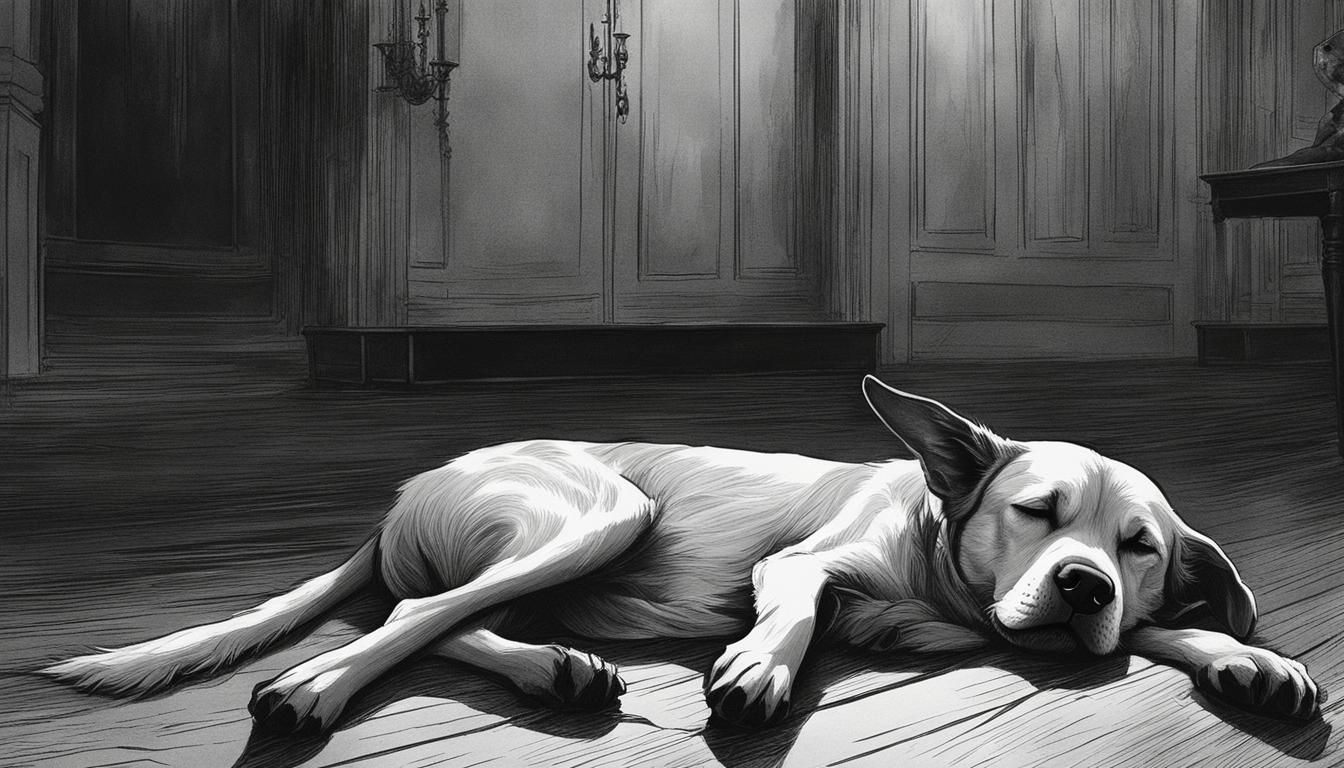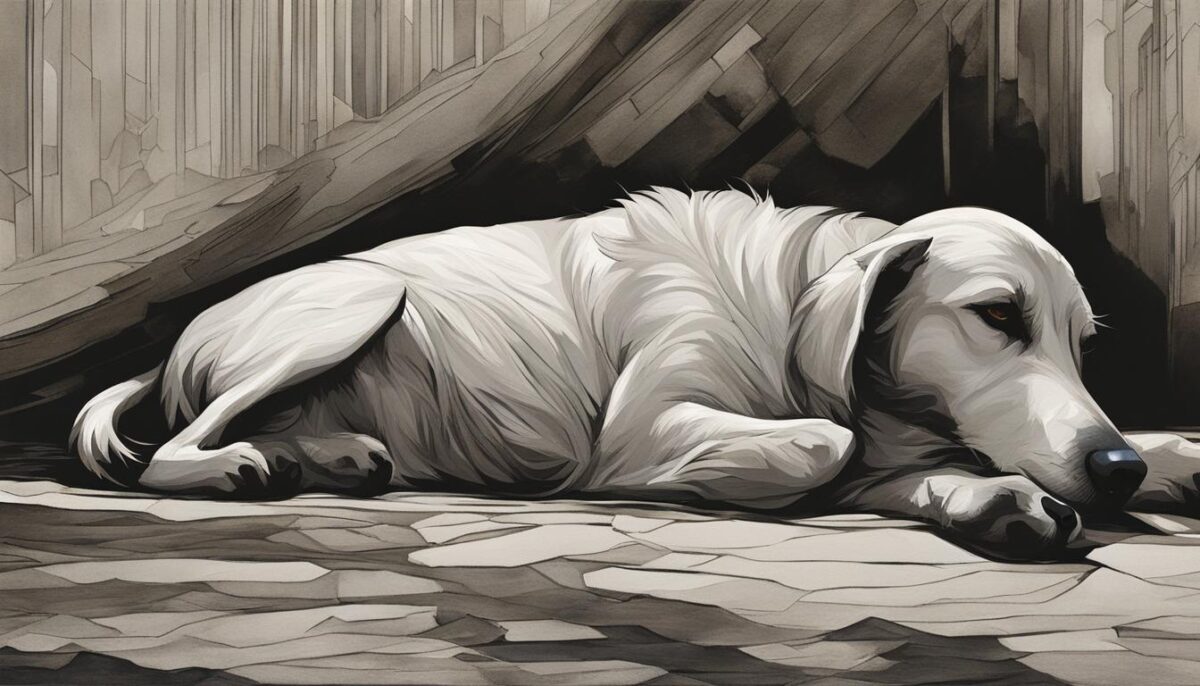Have you ever wondered if your furry friend has trouble sleeping just like we do? It’s important to know that dogs can have sleep issues too! Just like humans, dogs can experience problems when they’re trying to catch some Z’s. Understanding pet health, specifically dogs’ sleep issues, is a key part of taking good care of our pets. Sometimes, our pups might seem stuck and unable to move while they are asleep or waking up. This could be a sign of something called canine sleep paralysis. But don’t worry, this doesn’t mean they are always in trouble. It’s all about keeping an eye on pets’ sleeping patterns to make sure they’re getting the rest they need.
Pay attention to how your dog sleeps. Do they look peaceful? If they seem to be struggling, it might be time to get a little help from a vet. Just like us, dogs need good sleep for good health. Let’s make sure we understand what’s normal and what might be a signal for us to step in and help.
Key Takeaways
- Just like people, dogs can have sleep problems too.
- Watching your dog sleep can tell you a lot about their well-being.
- Some signs like not being able to move might look scary but can be helped.
- Canine sleep paralysis is one of the sleep issues dogs might face.
- Good sleep is super important for your dog’s overall health.
Understanding Your Dog’s Sleep Cycle
Have you ever watched your dog twitching in their sleep and wondered what’s happening? Just like you, dogs go through different stages of sleep, including one very important phase called REM sleep. It’s in this stage that your furry friend’s brain is busy at work. Let’s take a closer look at what goes on when your dog is dozing off.
The Role of REM Sleep in Dogs
The REM stage of a dog’s sleep cycle is quite similar to ours. REM stands for Rapid Eye Movement, and it’s the period when your dog’s brain is almost as active as when they’re awake. During this time, their body is getting the rest it needs, and their brain processes the day’s activities. So if you see your dog’s eyes moving under their eyelids, it means they’re likely in the middle of REM sleep. This is essential for their health, as it’s believed to support their learning and memory.
When thinking about pet sleep patterns, it’s important to understand how much sleep they need. Puppies, for instance, spend a whopping 18 to 20 hours asleep, with many of those hours spent in REM sleep! Adult dogs average about 12-14 hours, and for seniors, it can vary depending on their health and lifestyle.
Common Behaviors During Canine Sleep
Now, you might notice some common sleep behaviors that may have you wondering about your pet’s dream world. From your dog’s slight whisker twitches to their paws paddling as if they’re running in their sleep, these are all part of normal dog sleeping behavior.
- Whimpering or bark-like sounds
- Twitching facial muscles
- Paddling or flicking paws as if running
- Quick breathing or holding their breath momentarily
All these actions could be signs that your dog is having an exciting dream about chasing squirrels or playing fetch. Yet, it’s also essential to keep an eye on these behaviors – they should be mild and not too frequent. Major thrashing around or signs of stress during sleep can be a red flag, meaning it’s time to check in with your vet.
Understanding your dog’s sleep cycle, especially the part about canine REM sleep, helps you ensure they’re getting the restorative rest they need. Keep in mind, a happy and healthy dog is one that sleeps thoroughly, with all those adorable little twitches and sighs. It’s a sign of a sound sleeping buddy and makes for some of the sweetest moments of pet ownership.
The Phenomenon of Sleep Disorders in Dogs
Just like humans, dogs can have trouble sleeping. These troubles are known as canine sleep disorders, and they can make your furry friend feel tired or change how they act. Pet sleep health is important because good sleep helps dogs stay happy and healthy. If your dog is acting strangely, like being very sleepy all day or moving a lot in their sleep, they might have a sleeping disorder.
Let’s talk about some of the sleep problems dogs can face:
- Insomnia: Sometimes, dogs can have a hard time falling asleep. This might happen if they’re feeling anxious or not comfortable.
- Sleep apnea: This is when a dog stops breathing for a little bit while they’re sleeping. It often happens in dogs with short noses, like Bulldogs.
- Narcolepsy: A dog with this disorder can fall asleep suddenly, even if they’re in the middle of playing or eating.
- REM sleep behavior disorder: During sleep, some dogs might move around a lot or even bark. It looks like they’re acting out their dreams.
If you notice any of these signs, it might be time to talk to a vet. They can help figure out what’s going on and how to make your dog sleep better.
Remember, good sleep is just as important for pets as it is for people. Looking after your dog’s sleep is a big part of taking care of their health.
Here’s a table that can help you see the differences between some common sleep disorders in dogs:
| Disorder | Symptoms | Common in Breeds |
|---|---|---|
| Insomnia | Hard time sleeping, restlessness | All breeds |
| Sleep Apnea | Heavy snoring, breathing pauses | Brachycephalic breeds like Pugs, Bulldogs |
| Narcolepsy | Sudden sleepiness, falling asleep without warning | All breeds, but rare |
| REM Sleep Behavior Disorder | Physical activity during sleep, barking | Younger dogs, not breed-specific |
Every dog is different, so if you’re worried about your dog’s sleep, it’s always best to get help from a vet. They’ll know what to do to make sure your dog gets the rest they need.
Can Dogs Get Sleep Paralysis?
Have you ever seen your dog lying still while sleeping, almost as if they are frozen? This might make you wonder, can dogs get sleep paralysis? While our furry friends don’t experience the exact condition known in humans as sleep paralysis, they can show signs that look a lot like it. When dogs enter REM sleep, the deep sleep where dreams happen, their bodies normally don’t move much to keep them from acting out their dreams.
However, sometimes there can be a mix-up in their sleep patterns. This is when you might see canine sleep paralysis or dog sleep dysfunction. During these moments, your dog might seem like they can’t move at all, even though they are trying to. This pet immobility during sleep can be linked to a few different sleep problems in dogs.
Just like humans, dogs need their muscles to relax during REM sleep. But if something interrupts this, they might not be able to move properly. Sometimes, it might look like they have too much energy in their sleep, kicking or running. Other times, it seems like they can’t move, even if they should be awake and alert. If your dog is sleeping and seems stuck, it might be because they are in a deep part of their sleep cycle.
If you notice your dog having trouble like this too often, it’s a good idea to check in with your vet. They can help figure out if your buddy has a sleep issue and what you can do. After all, we want our pets to have sweet dreams and restful nights, just like we do!
Other Sleep Disturbances Among Dogs
Our furry friends can also have trouble sleeping. Just like us, dogs can face different sleep issues. In this section, we’ll talk about what can disturb a dog’s sleep and what you can do to help.
Insomnia and Its Underlying Causes in Canines
Having a dog who can’t sleep is tough. Canine insomnia can happen for many reasons, like feeling worried, being in pain, or having itchy skin. You might notice older dogs, or those who seem confused, may not sleep well.
How Sleep Apnea Affects Certain Dog Breeds
Sleep apnea in dogs is when they stop breathing for a bit while they are asleep. This happens more in dogs with short noses, like Bulldogs. They might snore loudly or wake up often because they can’t breathe well.
Dealing With Narcolepsy in Your Furry Friend
When a dog has narcolepsy, they might suddenly fall asleep, even when they’re playing or eating. It can be a little scary, but knowing how to help them stay safe is key.
Understanding REM Sleep Behavior Disorder in Dogs
Sometimes, when dogs are in a deep sleep, they move around because their muscles don’t relax the way they should. This is called REM sleep disorder. If your dog acts like they’re running or catching something in their sleep, that’s what you’re seeing.
When to Seek Veterinary Care for Sleep Issues
If your dog is showing weird signs when it sleeps, like snoring really loud, waking up over and over again, or suddenly falling over, it’s super important to talk to a vet. These could be clues that something’s not right, and you want to make sure your furry buddy is okay. Getting help from a vet is the best way to figure out what’s going on and how to fix it.
Recognizing Abnormal Sleep Signs in Pets
Keep an eye out for things like if your pet stops breathing and doesn’t start again, or if their gums turn a funny color. These are big warning signs that mean you should get help from a vet right away. Being quick about getting your pet checked out means you can start taking care of the problem sooner, which is way better for your pet’s health and happiness.
Video Recording Behaviors: A Tool for Diagnosis
Sometimes, you might need to show the vet what’s going on with your pet while they’re sleeping. A good way to do this is by making a video of your pet when they’re snoozing. This can help the vet see what’s wrong and come up with the best plan to help your pet.
Here’s a table that shows some of the weird sleep signs to look for and what they might mean. If you see any of these in your pet, it’s a good idea to chat with your vet:
| Abnormal Sleep Sign | Possible Issue to Check with Vet |
|---|---|
| Loud Snoring | Breathing Problems or Sleep Apnea |
| Waking Up a Lot | Insomnia or Discomfort |
| Sudden Collapse | Narcolepsy or Weakness |
| Breathing Stops Briefly | Respiratory Issue or Sleep Apnea |
| Gums Change Color | Oxygen Level Problems |
| Shaking or Twitching in Sleep | REM Sleep Behavior Disorder |
Remember, your pet depends on you to keep an eye on their sleep and health. If you notice anything strange, seek veterinary care for sleep issues right away. You know your pet better than anyone, so trust what you see and take action to keep them happy and healthy!
Managing and Treating Canine Sleep Disorders
Treating dog sleep disorders starts with understanding exactly what your furry friend is going through. Each disorder requires a different approach, and it’s all about keeping your dog’s sleep health at its best. Let’s talk about the ways to help your dog if they can’t sleep well.
For starters, managing canine insomnia might involve giving medications prescribed by your vet. These can help with anxiety that keeps your pooch awake at night. Some dogs might need changes in their nightly routine or extra help for conditions like arthritis that make it hard to get comfortable and fall asleep.
If your dog snores a lot or stops breathing for short times during sleep, they might have sleep apnea. This could mean they need to lose some weight, or in some cases, they might even need surgery to help them breathe easier while they snooze.
Narcolepsy in dogs, where they suddenly fall asleep, can sometimes be treated with medications too. Things like antidepressants or stimulants can help, along with changes in your dog’s life to keep them safe if they doze off unexpectedly.
Remember, the key to managing and effectively treating your dog’s sleep disorder is to closely follow your veterinarian’s advice.
Now, let’s look at a summary table of the most common sleep disorders in dogs, their symptoms, and potential treatments:
| Sleep Disorder | Common Symptoms | Potential Treatments |
|---|---|---|
| Canine Insomnia | Difficulty falling asleep, restlessness at night | Anxiety medications, lifestyle changes |
| Sleep Apnea | Loud snoring, gasping for air | Weight management, surgery |
| Narcolepsy | Sudden sleep episodes, collapse during activity | Antidepressants, stimulants, lifestyle adjustments |
| REM Sleep Behavior Disorder | Active movement or vocalizing during sleep | Medications, treatment for co-existing conditions |
If your dog is facing sleep issues, it’s important to observe them and keep track of what’s going on. Don’t wait to get help if things don’t look right because a good night’s sleep is just as important for your dog as it is for you. With the right care, your dog can have happy dreams and wake up ready to play and enjoy the day!
Conclusion
As a pet owner, you play a big part in your dog’s happiness and health. Keeping an eye on how your dog sleeps is a key step to making sure they stay healthy. When you watch your furry friend snooze, you learn what’s normal for them. This way, if something changes, you’ll spot it right away. A good night’s sleep can help to keep your dog healthy, and it begins with you.
The Importance of Monitoring Your Dog’s Sleep
By monitoring dog sleep, you understand their resting patterns and can catch any unusual signs early. This is just like when you feel great after a good sleep—dogs need that, too. It helps them be their best, playful selves. So, you’re not just a pet owner; you’re a sleep detective, looking out for any clues that something might be wrong.
Enhancing Your Pet’s Sleep Quality for Better Health
Improving canine health starts with quality snooze time. You can make their sleep even better by creating a cozy spot for them to rest. Try to keep bedtimes and wake-up times the same every day. Remember, when your dog gets a good sleep, they feel great! And when your pet feels great, they make your life even more fun. So, let’s make sure they have the dreamiest naps and the deepest night’s sleeps every day!
FAQ
Can dogs experience a form of sleep paralysis?
While not exactly termed as “sleep paralysis,” dogs can show signs similar to the condition when experiencing REM sleep behavior disorder or other sleep issues that affect their muscle paralysis during sleep.
What is the role of REM sleep in dogs?
REM sleep is crucial for dogs as it’s when their brains process and consolidate the day’s experiences. This stage of sleep is also when dogs are likely to dream, as indicated by physical movements like twitching or rapid eye movement.
What are common behaviors I might observe in my dog during sleep?
Typical canine sleep behaviors include whimpering, paw flicking, leg twitching, and other slight movements. Such actions represent ‘active’ sleep where there may be higher brain activity, possibly related to dreaming.
How can I tell if my dog has a sleep disorder?
If you see your dog displaying unusual behaviors such as pacing at night, excessive whining, acting confused, loud snoring, waking up frequently, or having sudden collapses, these could be signs of a sleep disorder. Monitoring and seeking veterinary advice is essential.
Are certain dog breeds more prone to sleep apnea?
Yes, brachycephalic (short-nosed) breeds, including Bulldogs and Pugs, are more susceptible to sleep apnea due to their physical structure, which can affect their breathing during sleep.
How is insomnia treated in dogs?
Canine insomnia is treated by addressing underlying causes such as anxiety or pain, possibly with medications, and making behavioral or environmental adjustments to create a conducive sleeping atmosphere.
What should I do if I suspect my dog has a sleep disorder?
If you suspect a sleep disorder, keep a record of your dog’s sleep behaviors and consult with a veterinarian. Immediate care is necessary for severe symptoms like non-restarting breathing or gum discoloration.
How can I enhance my dog’s sleep quality for better health?
Enhancing your dog’s sleep quality includes providing a comfortable sleep environment, maintaining a consistent routine, managing any health issues, and making necessary lifestyle adjustments to promote sound sleep.
What is narcolepsy, and how does it manifest in dogs?
Narcolepsy in dogs is characterized by sudden bouts of sleep or collapses, especially during periods of excitement. Affected dogs will fall asleep rapidly and unexpectedly.
When should I seek veterinary care for my dog’s sleep issues?
You should seek veterinary care if you notice any significant changes in your dog’s sleep patterns, behaviors that disrupt sleep, or physical symptoms like collapse or difficulty breathing during sleep.
Can I do anything at home to help manage my dog’s sleep disorder?
Yes, you can help manage your dog’s sleep disorder by establishing a calming bedtime routine, ensuring your dog gets plenty of exercises during the day, and keeping their sleeping area quiet and comfortable. However, always consult your veterinarian for a tailored management plan.
What does REM sleep behavior disorder look like in dogs?
REM sleep behavior disorder in dogs can manifest as violent movements or vocalizations during sleep. It’s caused by the brain’s failure to properly paralyze the major muscles during REM sleep, which prevents dogs from acting out their dreams.


